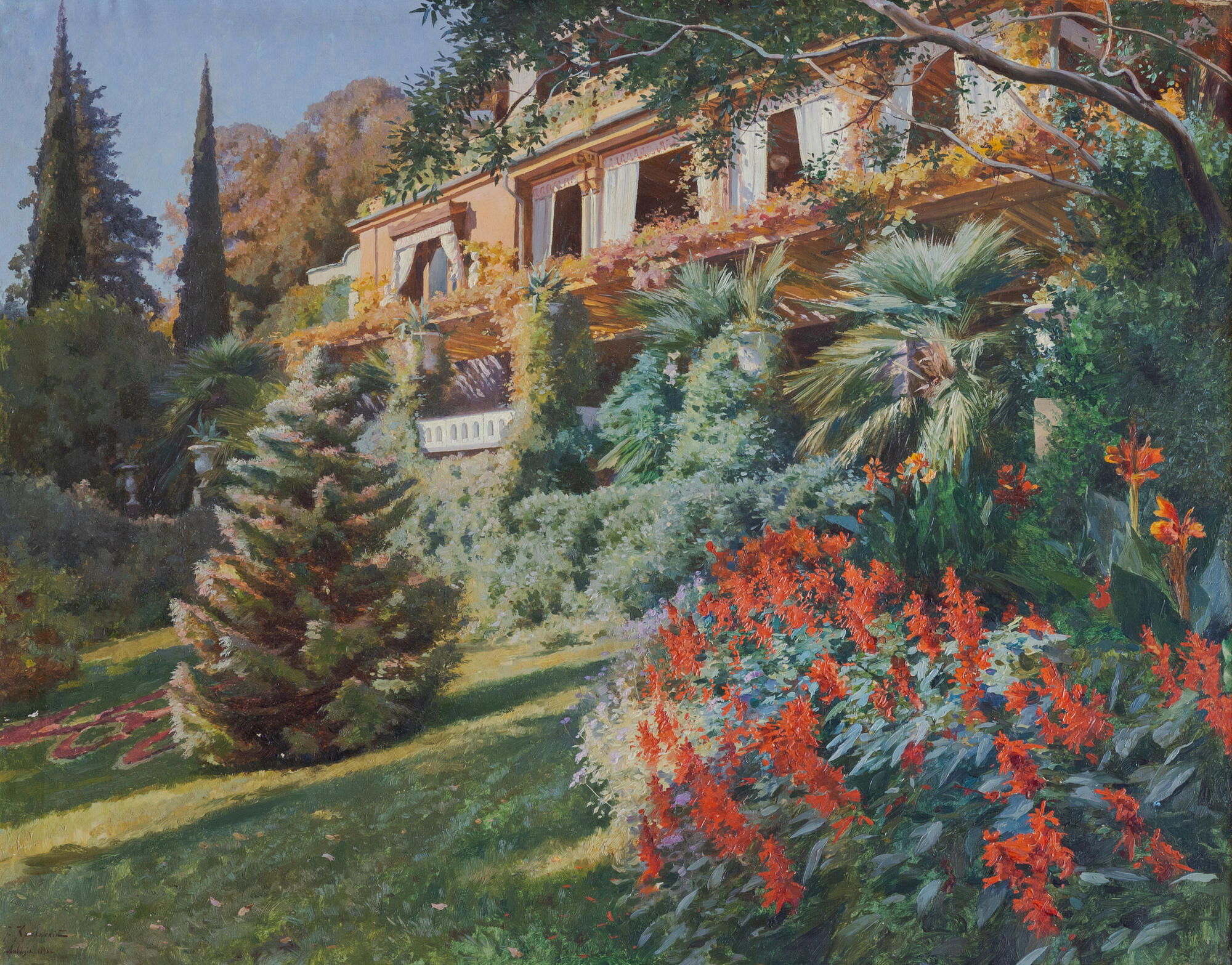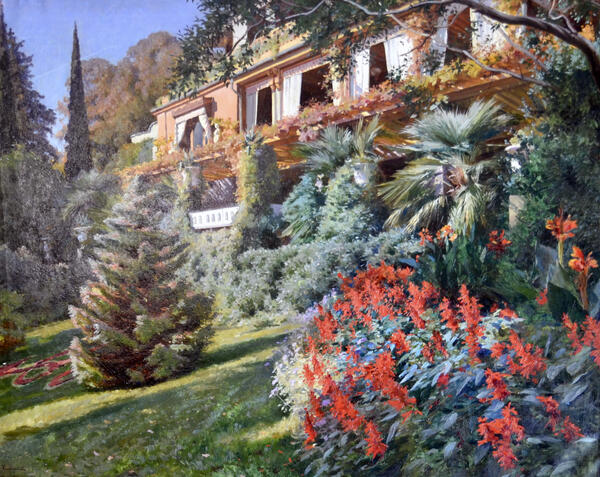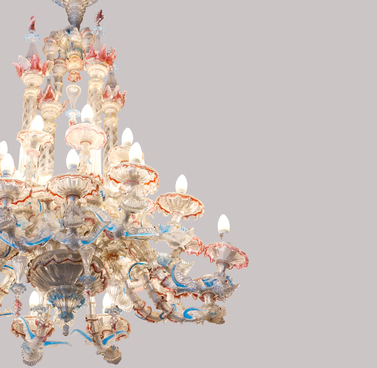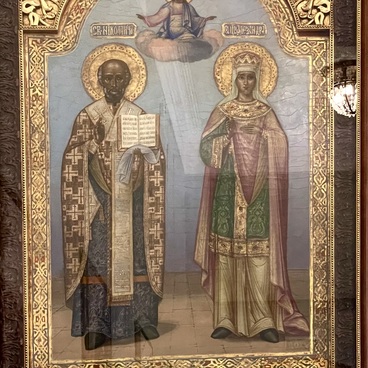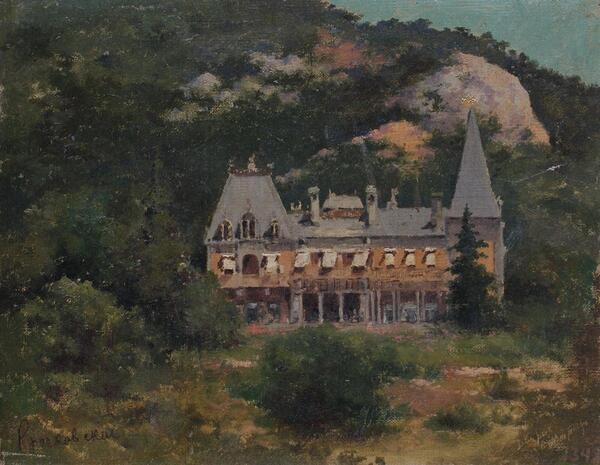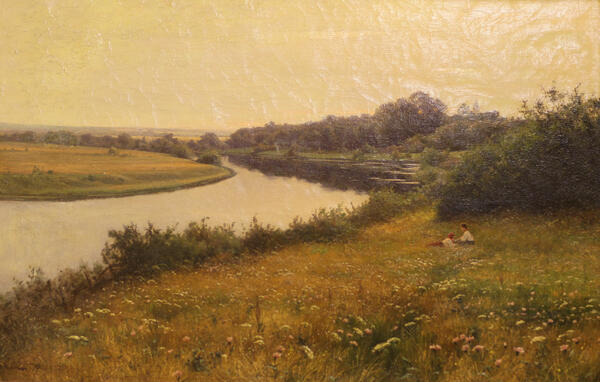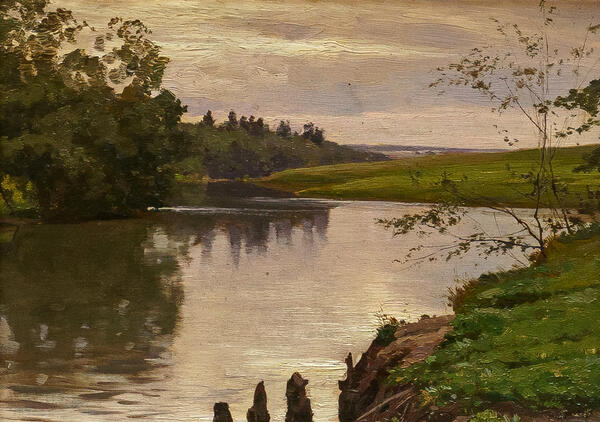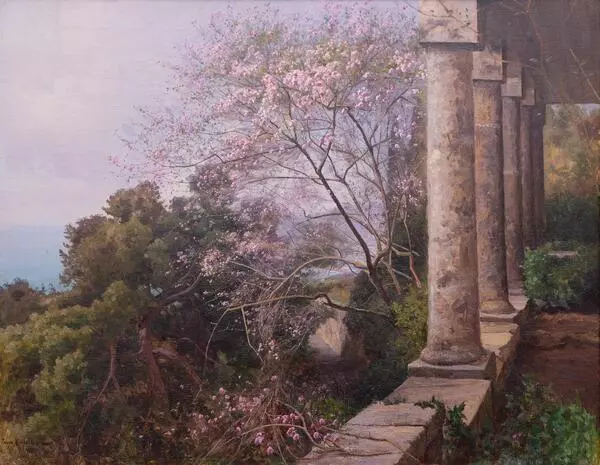The art collection of the Livadia Palace Museum presents a painting “Old Livadia Palace” by the famous late 19th-century artist Iosif Krachkovsky.
The picture portrays a landscape in Crimea — a view of the corner of the Livadia park. The foreground depicts lush exotic plants. The right side of the painting shows bright red canna lilies and other red, white and purple flowers. Behind them are broadleaf trees, vining plants and fan-leaved palms. The left side depicts a small green clearing with conifers. The blue sky is seen in the upper left corner. In the middle ground is the southern veranda of the old Livadia Palace with a large balustrade and white curtains.
Iosif Yevstafyevich Krachkovsky (1854–1914) was a Russian landscape painter of Polish origin. He showed interest in painting and music from an early age. After graduating from a gymnasium in Saint Petersburg, Krachkovsky spent several years at a conservatory but his penchant for painting outweighed that for music. From 1871 to 1880, Krachkovsky studied at the Saint Petersburg Academy of Arts under a wonderful artist and teacher Mikhail Konstantinovich Klodt. After he graduated from the Academy, Krachkovsky received a government stipend for further training in Europe (1880–1884). Upon returning home, Iosif Krachkovsky earned the title of an academician for the works he had created during his stay in Europe, as well as for “excellent knowledge of landscape painting.”
At the end of the 19th century, the public particularly favored landscapes conveying the beauties of Southern Russia, Italy and France. It was then that Krachkovsky rose to fame. In the 1890s, the artist visited Crimea, where he painted in Livadia, Massandra and Oreanda, taking numerous commissions from the Russian nobility and the Imperial family. The artist grew so fond of southern nature that every spring and autumn he went to Crimea, Italy or the French Riviera, and his paintings were filled with the motifs of southern spring with its bright colors of blooming trees, stunning tropical flowers, and soft tones of vast expanses and the sky ever since.
In 1902, Krachkovsky’s first solo exhibition was held and was “honored by a visit from Their Imperial Majesties and Most High and August Personages.” Nicholas II acquired a few of the artist’s pieces. The success of this exhibition brought Iosif Krachkovsky great fame, numerous commissions from high society and interest in his works from Russian and European collectors.
The picture portrays a landscape in Crimea — a view of the corner of the Livadia park. The foreground depicts lush exotic plants. The right side of the painting shows bright red canna lilies and other red, white and purple flowers. Behind them are broadleaf trees, vining plants and fan-leaved palms. The left side depicts a small green clearing with conifers. The blue sky is seen in the upper left corner. In the middle ground is the southern veranda of the old Livadia Palace with a large balustrade and white curtains.
Iosif Yevstafyevich Krachkovsky (1854–1914) was a Russian landscape painter of Polish origin. He showed interest in painting and music from an early age. After graduating from a gymnasium in Saint Petersburg, Krachkovsky spent several years at a conservatory but his penchant for painting outweighed that for music. From 1871 to 1880, Krachkovsky studied at the Saint Petersburg Academy of Arts under a wonderful artist and teacher Mikhail Konstantinovich Klodt. After he graduated from the Academy, Krachkovsky received a government stipend for further training in Europe (1880–1884). Upon returning home, Iosif Krachkovsky earned the title of an academician for the works he had created during his stay in Europe, as well as for “excellent knowledge of landscape painting.”
At the end of the 19th century, the public particularly favored landscapes conveying the beauties of Southern Russia, Italy and France. It was then that Krachkovsky rose to fame. In the 1890s, the artist visited Crimea, where he painted in Livadia, Massandra and Oreanda, taking numerous commissions from the Russian nobility and the Imperial family. The artist grew so fond of southern nature that every spring and autumn he went to Crimea, Italy or the French Riviera, and his paintings were filled with the motifs of southern spring with its bright colors of blooming trees, stunning tropical flowers, and soft tones of vast expanses and the sky ever since.
In 1902, Krachkovsky’s first solo exhibition was held and was “honored by a visit from Their Imperial Majesties and Most High and August Personages.” Nicholas II acquired a few of the artist’s pieces. The success of this exhibition brought Iosif Krachkovsky great fame, numerous commissions from high society and interest in his works from Russian and European collectors.
